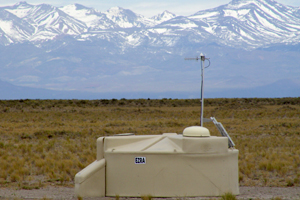Auger detectors will search for cosmic rays’ mysterious source
By Steve KoppesNews Office
 In this view of the surface detector, nicknamed “Ezra,” one can see the battery box (at left), the electronics dome (top), and its solar panels and communications mast. The Andes Mountains provide a snow-capped backdrop to the west of the surface detector array. Watch related video:  Detecting Cosmic Rays: The Auger Observatory and Frontier Science Detecting Cosmic Rays: The Auger Observatory and Frontier Science
| |
Scientists throughout the world will focus their attention this year on an array of plastic water tanks deployed across the vast plain known as the Pampa Amarilla in western Argentina. The tanks comprise a major component of the Pierre Auger Observatory, the largest cosmic-ray detector ever operated.
“This is a new form of astronomy,” said Nobel laureate James Cronin, University Professor Emeritus in Physics and Astronomy & Astrophysics at Chicago. “The basic thrust for this is coming from particle physics.”
In the 1990s, Cronin and colleague Alan Watson of the University of Leeds initiated the project, which now encompasses 370 scientists from 16 nations. The editors of Science have selected the project as among the “Areas to Watch in 2006.”
“The speediest atomic nuclei in the universe, called ultrahigh-energy cosmic rays, may open a new frontier of physics,” reported Science in its December 2005 issue. “The sprawling Pierre Auger Observatory in Argentina will near completion in 2006, offering the best chance to explore those limits.”
Auger scientists seek to pierce the secrets of a phenomenon that has baffled scientists for nearly seven decades: what is the mysterious source from beyond the galaxy that periodically bombards Earth with these high-energy cosmic rays?
“These particles might be coming from jets of matter emitted by supermassive black holes. Or the particles could be accelerated by the magnetic fields of fast-spinning neutron stars. It could even be some effect coming from extra dimensions,” said Auger collaborator Angela Olinto, Chair and Associate Professor of Astronomy & Astrophysics.
High-energy cosmic rays consist of protons and other subatomic scraps of matter that fly through the universe at nearly the speed of light. The most powerful cosmic rays contain more than a hundred million times more energy than the particles produced in the world’s most powerful particle accelerator. When these rays collide with air molecules in Earth’s atmosphere, they trigger a shower that multiplies into billions of secondary particles before they reach the ground.
Construction of the observatory began in March 1999. More than half of the observatory’s 1,600 detectors are now collecting data. When completed later this year, the observatory will consist of a grid of cosmic-ray detectors and associated electronic instruments that covers 1,200 square miles of the Pampa Amarilla, approximately 600 miles west of Buenos Aires.
The Auger collaboration established the observatory in Argentina in part because earlier cosmic-ray experiments were set up in the Northern Hemisphere. “The Southern Hemisphere really has not been properly explored,” Cronin said.
The $50 million observatory must cover a wide area because high-energy cosmic rays are rare. Only one of these particles strikes any given square mile of Earth in a century. To detect these particles, the observatory combines two techniques that had been previously employed separately by earlier cosmic-ray observatories built in Utah and in Japan.
One technique consists largely of simple plastic water tanks, which serve as ground detectors. Measuring 5 feet tall and 12 feet in diameter and spaced at one-mile intervals, they will occasionally intercept a particle from the atmospheric cascade generated by cosmic rays. As the particle crosses from air into water its speed changes, producing a supersonic shock, much like an airplane does when it crosses the sound barrier, Olinto explained.
“As the particle crosses from the air into the water, its speed exceeds the velocity of light in the water, producing an optical shock wave, much like an airplane does when it crosses the sound barrier,” Olinto said.
The second technique involves fluorescence telescopes that can detect the ultraviolet light emissions generated in the atmosphere by cosmic rays. “With these two techniques we can actually see the shower developing in the atmosphere and see the leftovers of the shower as they hit the ground,” Olinto said.
“Really understanding the origin of these particles should open up a lot of different questions that we would like to answer next. But we have to start by knowing what they are and where they come from.”
![[Chronicle]](/images/sidebar_header_oct06.gif)